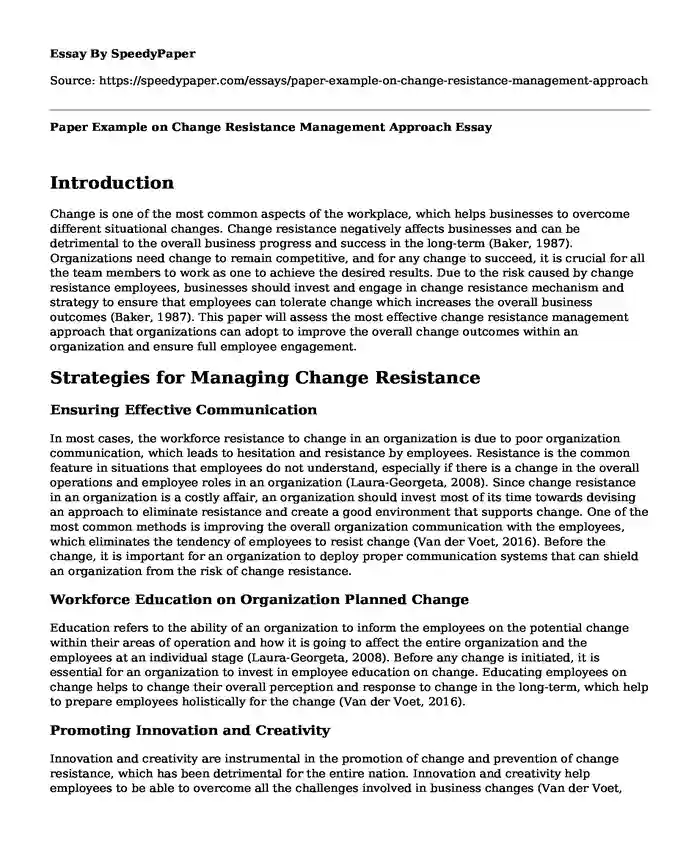
| Type of paper: | Essay |
| Categories: | Management |
| Pages: | 3 |
| Wordcount: | 754 words |
Introduction
Change is one of the most common aspects of the workplace, which helps businesses to overcome different situational changes. Change resistance negatively affects businesses and can be detrimental to the overall business progress and success in the long-term (Baker, 1987). Organizations need change to remain competitive, and for any change to succeed, it is crucial for all the team members to work as one to achieve the desired results. Due to the risk caused by change resistance employees, businesses should invest and engage in change resistance mechanism and strategy to ensure that employees can tolerate change which increases the overall business outcomes (Baker, 1987). This paper will assess the most effective change resistance management approach that organizations can adopt to improve the overall change outcomes within an organization and ensure full employee engagement.
Strategies for Managing Change Resistance
Ensuring Effective Communication
In most cases, the workforce resistance to change in an organization is due to poor organization communication, which leads to hesitation and resistance by employees. Resistance is the common feature in situations that employees do not understand, especially if there is a change in the overall operations and employee roles in an organization (Laura-Georgeta, 2008). Since change resistance in an organization is a costly affair, an organization should invest most of its time towards devising an approach to eliminate resistance and create a good environment that supports change. One of the most common methods is improving the overall organization communication with the employees, which eliminates the tendency of employees to resist change (Van der Voet, 2016). Before the change, it is important for an organization to deploy proper communication systems that can shield an organization from the risk of change resistance.
Workforce Education on Organization Planned Change
Education refers to the ability of an organization to inform the employees on the potential change within their areas of operation and how it is going to affect the entire organization and the employees at an individual stage (Laura-Georgeta, 2008). Before any change is initiated, it is essential for an organization to invest in employee education on change. Educating employees on change helps to change their overall perception and response to change in the long-term, which help to prepare employees holistically for the change (Van der Voet, 2016).
Promoting Innovation and Creativity
Innovation and creativity are instrumental in the promotion of change and prevention of change resistance, which has been detrimental for the entire nation. Innovation and creativity help employees to be able to overcome all the challenges involved in business changes (Van der Voet, 2016). Creativity in employees helps to establish perseverance and patience making employees more committed towards the organizational change despite the challenges and opposition that might be there due to the ability to navigate the challenges that come with organizational change.
Employee Involvement and Preparation
In most organizations, change fails due to the inability of businesses to value the input of the employees and uses them only as a means to achieve their goals. However, greater commitment and involvement of the employees is associated with greater employee engagement to an organization change, which is associated with the greater success of change initiated within an organization. As such, managers should constantly involve the employees in the change process from the beginning instead of making them execution agents of the change activities after all the plans have been laid down (Laura-Georgeta, 2008). Involving the employees allows the organization to equip them with the skills necessary to achieve the necessary goals and handle change activities appropriately.
Conclusion
Change is essential for all business organizations and involves careful evaluation and execution to ensure that employees are involved. Change has many challenges and the most effective approach of ensuring business success is effective communication which should begin before the change is implemented within an organization. Communication allows businesses to involve the employees and to prepare them for change, which has a more effective impact in supporting change. Communication efficiency allows a business to prepare the employees for change and instigate them towards greater engagement in organizational change.
References
Baker, S. L. (1987). Managing resistance to change. Allerton Park Institute (29th: 1987). Retrieved from https://pdfs.semanticscholar.org/a8e4/dad681a9fab5bba3b4e6e7a78c41c0021717.pdf
Laura-Georgeta, T. (2008). Change management-Resistance to the change. Annals of the University of Oradea, Economic Science Series, 17(4), 622-624. Retrieved from http://steconomiceuoradea.ro/anale/volume/2008/v4-management-marketing/112.pdf
Van der Voet, J. (2016). Change leadership and public sector organizational change: Examining the interactions of transformational leadership style and red tape. The American Review of Public Administration, 46(6), 660-682.
Cite this page
Paper Example on Change Resistance Management Approach. (2023, Jan 28). Retrieved from https://speedypaper.com/essays/paper-example-on-change-resistance-management-approach
Request Removal
If you are the original author of this essay and no longer wish to have it published on the SpeedyPaper website, please click below to request its removal:
- Leadership Definition Essay Examples
- Essay Example on Mental Illness and Homelessness
- The Mandala Tree of Life - Free Essay Example
- Intercultural Competence for Arabic Learners - Statistics Essay Sample
- Free Paper Sample Describing Hooks for Essays to Get Your Reader Hooked
- Essay Sample Named My Parent's Divorce
- Free Essay: Statement of Purpose for Applying Software Development
Popular categories




